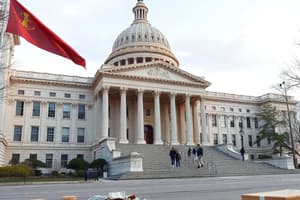Podcast
Questions and Answers
What was the purpose of devaluing the rupee by 18-19 percent in July 1991?
What was the purpose of devaluing the rupee by 18-19 percent in July 1991?
- To stabilize the foreign exchange market
- To increase government revenue
- To reduce foreign direct investment
- To encourage exports and discourage imports (correct)
What was the rate at which customs duty was reduced by 1997-98?
What was the rate at which customs duty was reduced by 1997-98?
- 50%
- 40% (correct)
- 25%
- 10%
Which system was introduced in 1992-93 to manage exchange rates in India?
Which system was introduced in 1992-93 to manage exchange rates in India?
- Managed floating exchange rate system
- Fixed exchange rate system
- Unified exchange rate system
- Liberalised exchange rate management system (LERMS) (correct)
What major step was taken to improve India's balance of payments?
What major step was taken to improve India's balance of payments?
What did the introduction of service tax in 1994-95 contribute to?
What did the introduction of service tax in 1994-95 contribute to?
What was the main goal of structural reforms implemented in the economy?
What was the main goal of structural reforms implemented in the economy?
What percentage of foreign exchange was to be surrendered at the official rate under the dual exchange rate system?
What percentage of foreign exchange was to be surrendered at the official rate under the dual exchange rate system?
Which of the following was a consequence of the economic reforms in India?
Which of the following was a consequence of the economic reforms in India?
Which exchange rate system was adopted in India after the liberalised exchange rate management system?
Which exchange rate system was adopted in India after the liberalised exchange rate management system?
What type of foreign investment was encouraged to improve balance of payments?
What type of foreign investment was encouraged to improve balance of payments?
Study Notes
Government Finances and Fiscal Deficit
- Long-term financial trend indicated that revenue generation was lower than expenditure, resulting in a fiscal deficit.
- Significant rise in non-development expenditure (interest payments, defense spending, subsidies) contributed to the fiscal imbalance.
- Fiscal deficit escalated to 7.7% of GDP in 1990-91.
- Central government’s internal debt reached 48.6% of GDP due to financing the deficit through borrowings.
- Interest burden on the government soared to 29% of revenue expenditure in 1990-91, creating financial strain.
- High fiscal deficits in the 1980s were pivotal in triggering the 1991 economic crisis.
- A key objective of the New Economic Policy was to reduce the fiscal deficit.
Balance of Payments Crisis
- The Gulf crisis of 1990 led to a pronounced balance of payments crisis, peaking in summer 1991 with foreign exchange reserves dropping to around $1 billion.
- The current account deficit reached $9.7 billion or 3.2% of GDP in 1990-91 due to a surge in oil prices triggered by the Gulf War.
- Diminished remittances from Indian workers in the Gulf exacerbated the invisibles account deterioration.
- Foreign reserves plummeted from $3.1 billion in August 1990 to $896 million by January 1991, largely due to rising imports and falling remittances.
- The crisis was not just from trade deterioration but also reflected loss of confidence in government management, compounded by political instability and high fiscal deficits.
- India struggled to secure foreign loans due to downgrades in its credit rating and simultaneous outflow of non-resident deposits.
- By June 1991, the crisis was characterized as one of confidence, threatening potential default on international payments.
High Inflationary Pressure
- Wholesale prices in India increased at an annual rate of 8.2% from 1981-82 to 1993-94.
- Inflation hit a double-digit rate of 10.2% in 1990-91.
- Corporate tax rates were unified and reduced from 51.75%-57.5% to 35% in 1991-92 to stabilize revenue.
- Maximum customs duty was lowered from 250% to 40% by 1997-98 to enhance trade.
- Introduction of service tax in 1994-95 aimed at broadening the tax base.
- Enhanced tax compliance and stringent public expenditure management led to stabilization of the fiscal deficit.
Balance of Payments Adjustment
- Measures adopted to improve balance of payments included an 18-19% devaluation of the rupee in July 1991, encouraging exports and discouraging imports.
- Liberalized exchange rate management system (LERMS) was introduced in 1992-93, with a dual exchange rate structure.
- Unified exchange rate system implemented in 1993-94, promoting full convertibility in the current account.
- India transitioned to a managed floating exchange rate system.
- Policies were put in place to boost exports and import liberalization for technological upgrades in export sectors.
- Non-debt creating foreign inflows, including foreign direct and portfolio investments, were encouraged to bolster the economy.
Structural Reforms (Supply Side Management)
- Long-term structural reforms aimed at addressing bottlenecks hindering economic growth and enhancing supply of goods and services.
- Reforms targeted removal of obstacles in production, contributing to overall economic stability and efficiency.
Studying That Suits You
Use AI to generate personalized quizzes and flashcards to suit your learning preferences.
Related Documents
Description
Explore the long-term trends in government finances, focusing on the challenges posed by rising fiscal deficits. This quiz delves into the causes of increased non-development expenditures and their impact on the economy, particularly during the fiscal year 1990-91.




